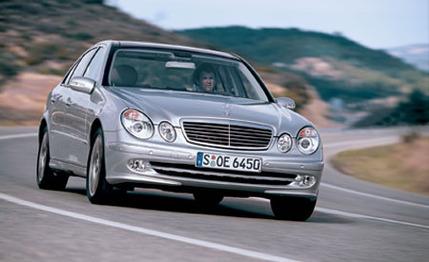
 First Drive Review
First Drive Review
The six-cylinder E-class sits smack in the middle of Mercedes' huge lineup and has until recently been ignored like a quiet middle child. Back before Mercedes started dropping V-8s into the mid-size E-class, the six-cylinder E-class was the shining star of the Benz squad-sportier than the S-class but more accomplished than the C-class and the 190E before it. In 1994 the E320 arrived with an inline-six that had 217 horsepower. The last of the E320s has 221 horsepower from an 18-valve V-6. It's hard to imagine going more than 10 years without a significant increase in power, but the E320 had to go through two generations with basically the same output. Now, that's neglect. In the intervening years, seemingly average cars have surpassed the output of the once proud E320. But despite lacking class-leading acceleration, an E320 squeaked out a one-point victory in a seven-car comparo [C/D, March 2003]. So in hopes of keeping its spot on the top of the heap, Mercedes is swapping the old V-6 for the more powerful 24-valve DOHC 3.5-liter V-6 introduced in the SLK roadster.
Packing 268 horsepower, 47 more than the 3.2-liter it replaces and only seven less than the 4.3-liter V-8 from the previous-generation E-class, the E350 accelerates with a renewed sense of urgency. Mercedes claims the E350 lops off 0.7 second from the dash to 62 mph. The last E320 we tested in '03 did away with 60 mph in 7.4 seconds, so we expect the E350 to run to 60 in less than seven. In the E-class the 3.5-liter doesn't pin you to the seat as it does in the lighter SLK350, nor will it threaten the superiority of the E500's 302 horsepower and 339 pound-feet of thrust, but the gain in acceleration is noticeable.
The 3.5-liter is a development of the 90-degree 3.2-liter V-6 that debuted in 1997. Bore and stroke have been increased to bring the displacement to 3.5 liters, there are now four valves per cylinder instead of three, and compression increases from 10.0:1 to 10.7:1. Those valves are actuated by four cams that benefit from variable timing on the exhaust and intake sides. Torque jumps from the 3.2-liter's 232 pound-feet to 258, available at 2400 rpm.
Making the most of the healthy power band is Mercedes' seven-speed automatic transmission with the hip-hop friendly name of 7G-Tronic. Initially only available on eight-cylinder Benzes, the seven-speed will eventually latch onto all Mercedes engines. Compared with the five-speed, the new transmission has closer ratios as well as a lower first gear (benefiting acceleration) and a taller top gear (to boost fuel economy). All-wheel-drive, or 4MATIC, versions of the E350 will soldier on with the five-speed automatic because there is not enough room for the slightly larger seven-speed and the all-wheel-drive transfer case.
Accelerate at less than wide-open throttle, and it's unlikely you'll notice the seven-speed transmission busily moving through its numerous cogs. Introduce the pedal to the floor long enough to force a shift at the 6400-rpm redline, and you'll barely see a drop in revs as the transmission whips from first gear to second. Marry the pedal to the floor, and the E350 will whisk you almost inaudibly to a governed Euro velocity of 155 mph. U.S.-bound E350s will be governed at 130 mph.
The transplant from the SLK350 to the E-class has entirely changed the character of the 3.5-liter V-6. In the SLK, engine intake and exhaust noise is always present, although never intrusive; in the E350, the intake noise wouldn't qualify as a whisper, and the exhaust has been similarly emasculated. We understand the subdued nature of the E350 is appropriate for a sedan, but we just love the way the SLK sounds, so we were disappointed that the new engine wasn't allowed to do its Ferrari impersonation.
The E-class is only the second stop on the new engine's tour of the Mercedes lineup. Soon the 3.5-liter V-6 will be as ubiquitous as steroids in baseball, giving a boost to several models starting with a C-class version, which we'll get in the States, and CLS-, SL-, and S-class versions, which we won't get. The E350 goes on sale this month as a 2006. Although Mercedes was coy about exact pricing, buyers shouldn't expect to pay much more for the added power and content of the E350; the base E320's price started a few dollars south of 50 grand, and the E350's should start a few dollars north. The changes are welcome, and the resulting E350 is a happier car than the E320. And that's what every middle child needs and wants-attention.